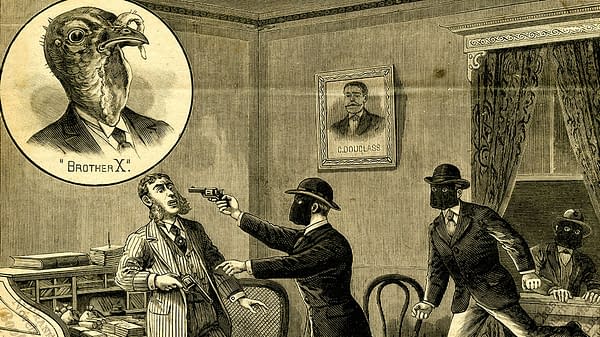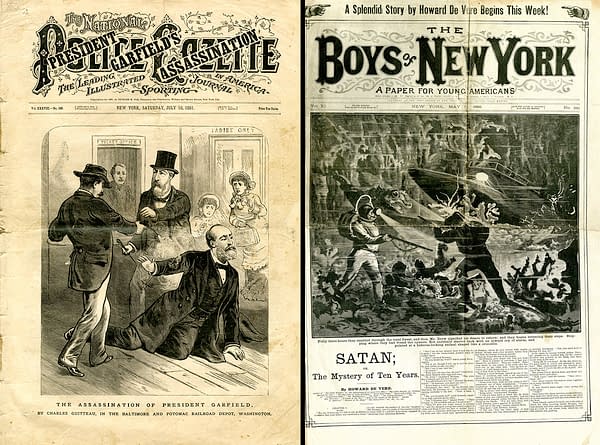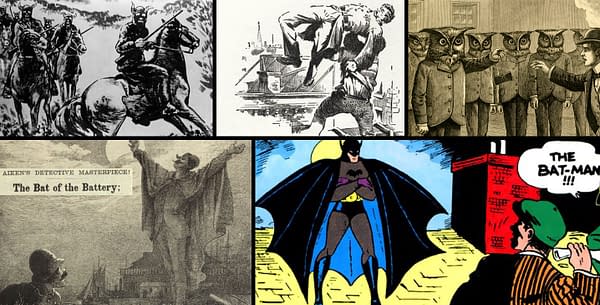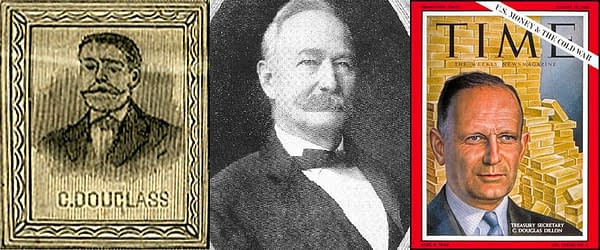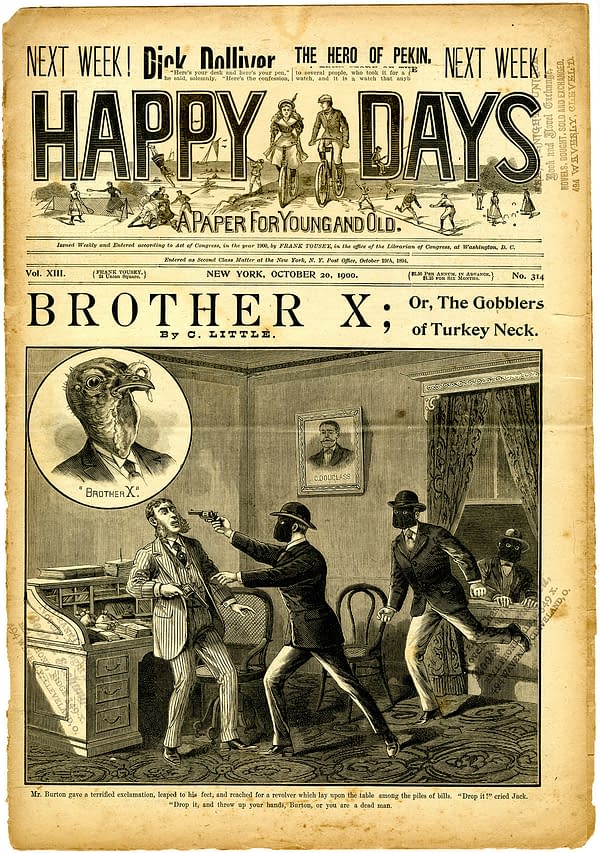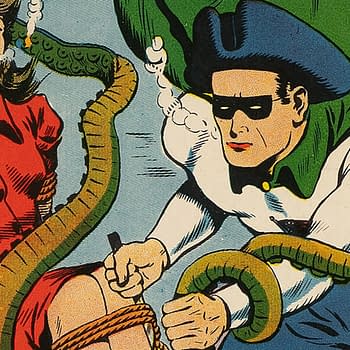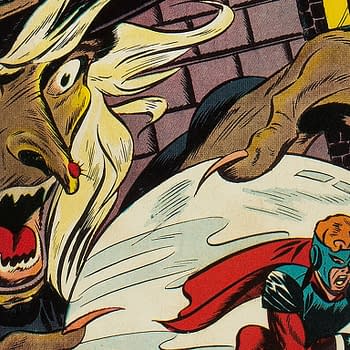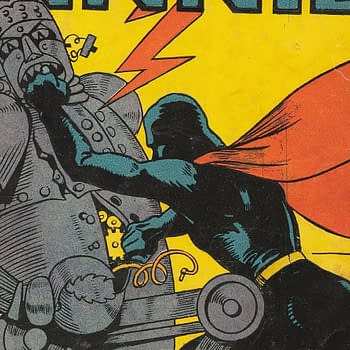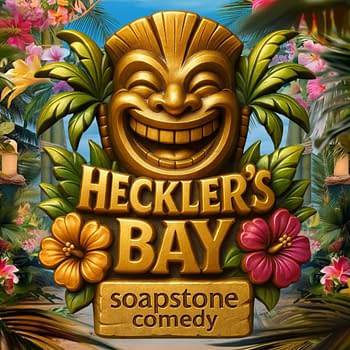Posted in: Dime Novels, Pop Culture | Tagged: frank tousey, george douglass, happy days
Turkey Vigilantes, Dead Rabbits, and the Greatest Thanksgiving Story of All Time
Happy Days #314, the October 20, 1900 cover-dated issue of the weekly story paper from publisher Frank Tousey, is very likely the greatest Thanksgiving newsstand fiction periodical cover in the history of history. The title story is the opening chapter of a multi-issue serial by "C. Little", a pen name for prolific dime novel-era writer Harvey K. Shakleford and featuring cover and illustrations by uncredited artists and engravers. The saga is mysteriously named: Brother X; Or, The Gobblers of Turkey Neck.
There's a lot to unpack there. Happy Days is a story paper title which ran weekly from 1894 to 1924 for 1563 issues. "Story Paper" was a common periodical newsstand fiction format of the second half of the 18th century through the very early 19th century. Think of it like this: it's a newspaper-style format, except containing fiction instead of news. Happy Days was tabloid size for most of its run.
The title is actually a reboot of the previous Frank Tousey-published series Boys of New York, the definitive title of the Blood and Thunder era, which ran weekly for exactly 1000 issues from 1877 to 1894. That original Boys of New York title is closer in tone to the contents of this rebooted saga than a name like Happy Days suggests. If you've seen the film Gangs of New York — even though the events of the film take place a little prior to the launch of Boys of New York — then you've got a general sense of the atmosphere that helped inspire the title. The street kids of the Five Points probably loved Boys of New York when it began, and read it along with the often-grisly true crime publication Police Gazette, which the character Bill the Butcher had mentioned in the film during Gangs of New York's prior era.
"The Gobblers of Turkey Neck" are essentially a street gang version of a secret society. The name comes from an initiation ceremony they use in this issue, involving the Turkey masks as worn by "Brother X" on the cover here.
They've wrapped up so many things I find fascinating about American history and old paper into this single story… the structure of the group is similar to a famous case of vigilantism by a group which called themselves "The Vigilance Committee of Southern Indiana", a group of some 50 men who wore masks and called each other by number. They had formed to take on the notorious Reno Gang, and their leader was "Number One". Likewise, the Gobblers have "Brother A", Brother B, C, etc.
The Gobblers also feel a lot like a next-generation version of the Five Points gangs such as the Dead Rabbits (who also play a role in Gangs of New York, by no coincidence). I think this is an example of how the costumed vigilantes (many of whom are largely forgotten because one particular group overshadows this entire niche of history — but there were many other groups of varying intent) of the Midwest and West were transformed into city-street NYC vigilante characters as well.
Take one part Baldknobbers of Missouri, one part Dead Rabbits of the Five Points, add a liberal dose of Skinwalker tradition to keep striking fear into the hearts of men, you end up with something like the Bat of the Battery. And after another generation or two, Batman.
The portrait on the wall in the scene on the cover of this issue of Happy Days gives us a clue as to what the story is really about — they're not robbing some hapless bean counter, it's a prank against a wealthy and heartless mill owner gone horribly awry, and a symbolic struggle of the one percent vs the working class that every generation comes to know. Frank Tousey as a publisher explored this sort of concept from several different angles throughout much of its history of the 1890s and early 1900s.
"G. Douglass" here is George Douglass, well known shipping and mercantile magnate of the earlier 19th century, whose son founded the firm which ultimately became Dun & Bradstreet. Douglass's son-in-law Clarence Dillon was just beginning his Wall Street career at the time this issue of Happy Days was on the newsstand. He became a bond broker whose firm ultimately produced a rather eyebrow-raising number of partners who moved from that Wall Street firm into senior govt roles, including a Secretary of the Navy and Secretary of Defense. Dillon's own son (George Douglass's grandson) became Secretary of the Treasury under Kennedy. Clarence Dillon was also one of the wealthiest men in America by the 1950s.
As for his firm, which was known as Dillon, Read & Co. through much of its lifespan, the company survived in various forms through mergers and acquisitions, ending up as sort of a brand name for a hedge fund for its then-parent, investment bank UBS. Dillon Read Capital Management was closed in 2007 after incurring $150 million of losses in the first quarter of that year.
All of which is to say… "C. Little" aka Harvey K. Shackleford? A very prescient fellow who dropped a lot of such gems in his work for the story papers.


